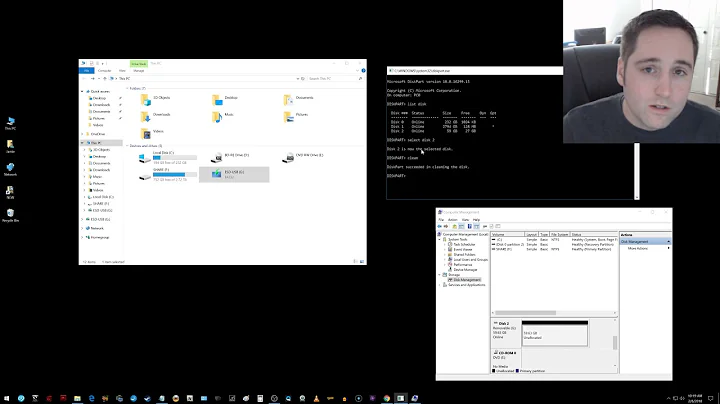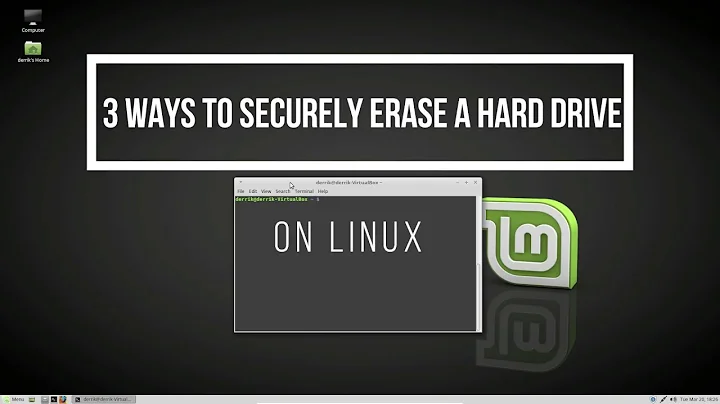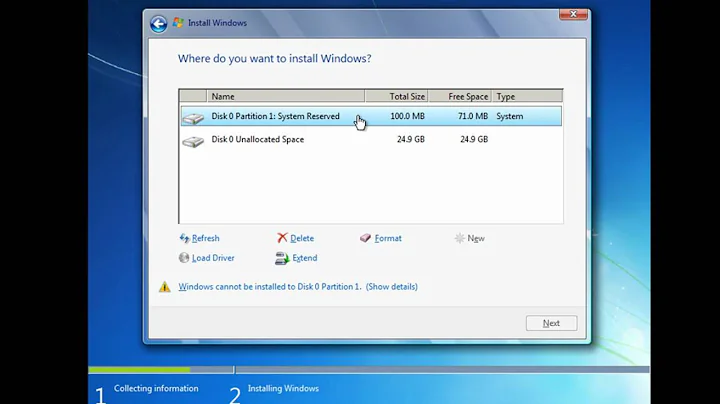How do I reset the factory capacity of harddisks on win7 or ubuntu
Solution 1
740GB is very close to the number we expect when a > 2 TiB disk is addressed by a system that only supports 32-bit LBAs:
Your 3 TB disk has about 3E12 / 512 = 5,859,375,000 = 0x15D3EF798 LBAs. I say "about" because almost all drives provide just a little more than the advertised capacity. (Not nearly enough to get up to 3 TiB, though!) Windows will display the drive capacity with a binary "T", meaning 1024 to the fourth instead of 1000 to the fourth, so it will say it is about 2.73 TB. (It really should say 2.73 TiB, or 3 TB, but that is another discussion...)
Now... if something in the chain only supports 32-bit LBAs, the number of LBAs becomes 0x5D3EF798 = 1,564,407,704 decimal LBAs. At 512 bytes/block that is about 801 GB (decimal G).
But Windows displays disk and file sizes using binary prefixes (as it does RAM sizes), so that is displayed as 746 "GB" (should be displayed as 746 GiB). Or maybe 745.96 GiB.
I originally had this as a comment to the question, not an answer... but I needed more than 500 characters to add some additional detail. This is not an "answer" as it does not solve your problem, but it may suggest a next step. I can't explain the "progressive" decline, though.
Solution 2
This is a large drive (>2 TB) with 512 byte sectors. Multiple things can go wrong.
Couple of possibilities here:
- Your BIOS doesn't support large disks. (You are using Win7 which can do it, if the BIOS allows it.)
- You are using a FDISK style partition table instead of GPT. Even Win7 needs the disk be partitioned as GPT in order to use it properly.
Be very careful with HD utilities. Many of those are not yet able to deal with such large disks. And even if the utility can do it, it needs the BIOS to be able to handle the disk correctly too !
This disk should have come with Hitachi's GPT partitioning tool.
Check the Hitachi web-site. Has all sorts of info about this problem and how to deal with it, specifically for this model of drive: http://www.hitachigst.com/deskstar-5k3000
Related videos on Youtube
ManiVenkat
Updated on September 18, 2022Comments
-
ManiVenkat over 1 year
I am new in Restful web services with JSON, I want to expose and consume the Restful web services using Spring MVC. Can you please guide me how can I do that. Thank you very much for your reply
-
Ben Campbell over 12 yearsDo you mean free space or drive capacity? If it really is the drive capacity changing, does the amount of data on the drive change as well? What does the capacity report in the BIOS?
-
 Admin over 12 yearsIf SMART says it's decreasing, I'd return the disk and get a new one.
Admin over 12 yearsIf SMART says it's decreasing, I'd return the disk and get a new one. -
 0gam almost 8 yearsYou can to search rest, json, spirng mvc . try.. and you take error and your code. come back.
0gam almost 8 yearsYou can to search rest, json, spirng mvc . try.. and you take error and your code. come back.
-
-
Jamie Hanrahan almost 10 yearsBut... 2.25 TB of defects?
-
 konqui almost 10 yearsI got your Point loosing more then 2/3 seems a little much for just (bad sectors e.g.) Maybe it will fit a similar Scenario then what happen to my 128 GB USB Stick. I Formated it from NTFS to ExFAT cause i wanna use it on Both Mac and PC. So formated and BAM i had a ~ 10 GB USB Stick. The Problem was caused by this: There used to be a little Software and a Image of a Virtual Drive (using really Good Data Compresssion Rate) on it which Auto Mounted. Obviously by formating the Drive they Both are gone.
konqui almost 10 yearsI got your Point loosing more then 2/3 seems a little much for just (bad sectors e.g.) Maybe it will fit a similar Scenario then what happen to my 128 GB USB Stick. I Formated it from NTFS to ExFAT cause i wanna use it on Both Mac and PC. So formated and BAM i had a ~ 10 GB USB Stick. The Problem was caused by this: There used to be a little Software and a Image of a Virtual Drive (using really Good Data Compresssion Rate) on it which Auto Mounted. Obviously by formating the Drive they Both are gone. -
 AStopher almost 9 yearsSlightly incorrect, the BIOS is not used at all after control is passed onto the operating system; the BIOS simply detects and sets up devices for use with the operating system. BIOSes which only use 32 bit integers cannot take drives of larger than around 2TB, which is likely the case here.
AStopher almost 9 yearsSlightly incorrect, the BIOS is not used at all after control is passed onto the operating system; the BIOS simply detects and sets up devices for use with the operating system. BIOSes which only use 32 bit integers cannot take drives of larger than around 2TB, which is likely the case here. -
Tonny almost 9 years@cybermonkey Your remark isn't entirely correct either. If Windows isn't using proper controller drivers it can fall-back on the basic BIOS routines. This can happen during setup/partitioning of Windows (if the Windows buildin drivers think they see a generic IDE or SATA interface) in which case you'll end up with an incorrect disk-layout, which remains AFTER Windows has loaded the proper drivers later on. I have seen this with Win7, IIRC the chipset was a Intel C600, maybe C610. It was a HP Workstation that used a Xeon-based, server-like, motherboard. Vista and G45 had the issue too.




